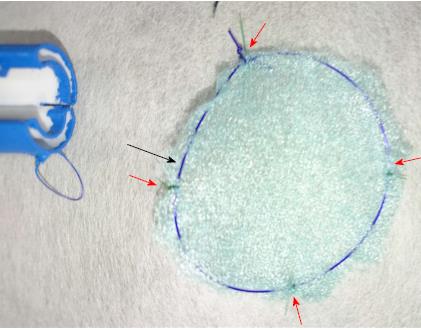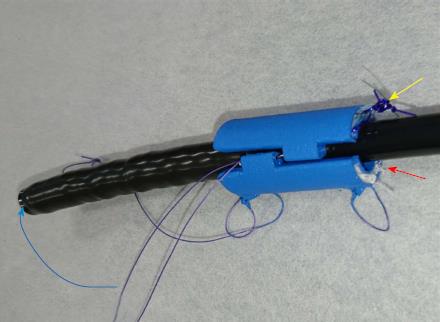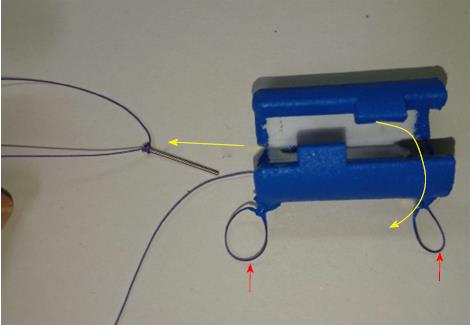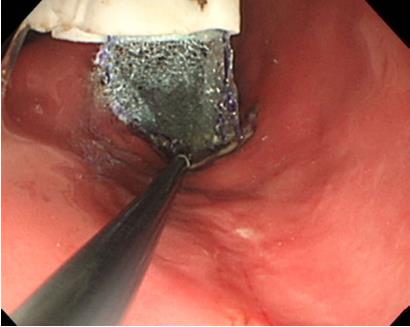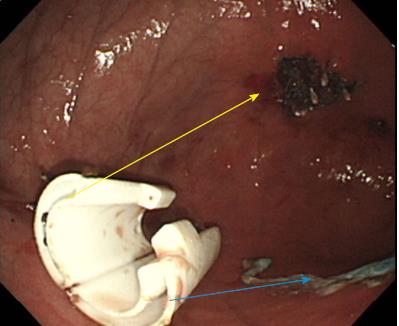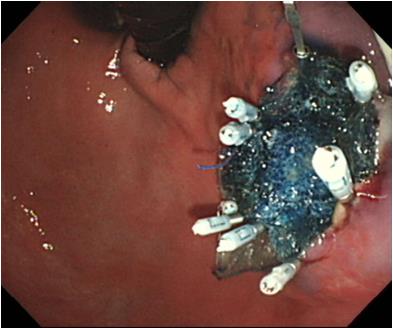Copyright
©The Author(s) 2018.
World J Gastroenterol. Jan 14, 2018; 24(2): 211-215
Published online Jan 14, 2018. doi: 10.3748/wjg.v24.i2.211
Published online Jan 14, 2018. doi: 10.3748/wjg.v24.i2.211
Figure 1 Preparation of polyglycolic acid sheets.
Polyglycolic acid sheets (PGAs) was able to be expanded by ring-shaped 1-0 polydioxanone (PDS) which have strong expansive force (black arrow). Ring-shaped 1-0 PDS was fixed with 4-0 PDS at 4 point to prevent PGAs from slipping out of place (red arrows).
Figure 2 Mount device delivery station system on pan endoscope.
Device delivery station system (DDSS) was mounted on pan endoscope with 2 chambers in which 16 cm2 large polyglycolic acid sheets (yellow arrow) and gauze (red arrow) were stored. It is possible for DDSS to store various kinds of surgical materials in its several chambers. It is very easy to open and detach DDSS by pulling the thread connected with tiny pin by grasping forceps through endoscopic channel (blue curved arrow).
Figure 3 Detachable of device delivery station system.
Device delivery station system (DDSS) is able to be opened and detached (yellow curved arrow) by pulling the thread connected with tiny pin (yellow arrow). Two ring-shaped threads are used to fix DDSS on the gastric wall (2 red arrows).
Figure 4 Delivery of dry polyglycolic acid sheet from device delivery station system.
Polyglycolic acid sheets was delivered and pulled out from device delivery station system chamber without getting wet with water.
Figure 5 Simultaneous deliveries of two polyglycolic acid sheet to two post-endoscopic submucosal dissections artificial ulcers.
Two polyglycolic acid sheets were pulled out from each 2 chambers and attached 2 post ulcers, respectively (yellow and blue arrows).
Figure 6 Mixture of Indigo Carmine and Beriplast P® for visualization.
0.5 mL Indigo Carmine mixed with transparent Beriplast P® for visualization of uniformly spraying onto ulcer floor made it possible to make tight attachment of polyglycolic acid sheets.
- Citation: Mori H, Kobara H, Nishiyama N, Masaki T. Novel concept of endoscopic device delivery station system for rapid and tight attachment of polyglycolic acid sheet. World J Gastroenterol 2018; 24(2): 211-215
- URL: https://www.wjgnet.com/1007-9327/full/v24/i2/211.htm
- DOI: https://dx.doi.org/10.3748/wjg.v24.i2.211









